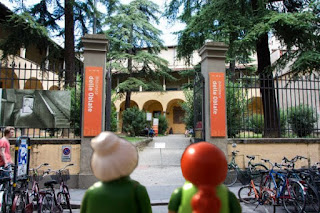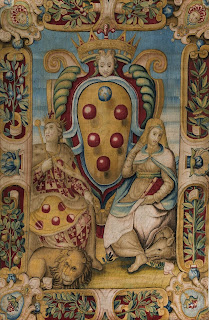 |
| Arriving to the Biblioteca delle Oblate, Firenze |
Today, The Grandma and her friends have visited the Oblate Library one of the most important libraries in Firenze. They want to have more information about The House of Medici, because it is impossible to understand Firenze, its History and its Culture without knowing the importance and the influence of this family over the city.
The House of Medici is an incredible saga of soldiers, politicians, popes, dukes, bankers, queens and mecenes whose influence in the Florentine History has marked its idiosyncrasy.
Before going to the library, The Grandma has studied a new lesson of her Intermediate Language Practice manual (Vocabulary 9).
More information: Personal Matters
The House of Medici was a Tuscan banking family and political dynasty that first began to gather prominence under Cosimo de' Medici in the Republic of Florence during the first half of the 15th century. The family originated in the Mugello region of Tuscany, and prospered gradually until it was able to fund the Medici Bank. This bank was the largest in Europe during the 15th century, and it facilitated the Medicis' rise to political power in Florence, although they officially remained citizens rather than monarchs until the 16th century.
The Medici produced four Popes of the Catholic Church -Pope Leo X (1513–1521), Pope Clement VII (1523–1534), Pope Pius IV (1559–1565) and Pope Leo XI (1605)- and two queens of France -Catherine de' Medici (1547–1589) and Marie de' Medici (1600–1630).
 |
| The House of Medici's shield |
In 1532, the family acquired the hereditary title Duke of Florence. In 1569, the duchy was elevated to the Grand Duchy of Tuscany after territorial expansion.
The Medicis ruled the Grand Duchy from its inception until 1737, with the death of Gian Gastone de' Medici. The grand duchy witnessed degrees of economic growth under the early grand dukes, but was bankrupt by the time of Cosimo III de' Medici (r. 1670-1723).
The Medicis' wealth and influence was initially derived from the textile trade guided by the wool guild of Florence, the Arte della Lana.
Like other families ruling in Italian signorie, the Medicis dominated their city's government, were able to bring Florence under their family's power, and created an environment in which art and humanism flourished. They and other families of Italy inspired the Italian Renaissance, such as the Visconti and Sforza in Milan, the Este in Ferrara, and the Gonzaga in Mantua.
The Medici Bank, from when it was created in 1397 to its fall in 1494, was one of the most prosperous and respected institutions in Europe, and the Medici family was considered the wealthiest in Europe for a time. From this base, they acquired political power initially in Florence and later in wider Italy and Europe. They were among the earliest businesses to use the general ledger system of accounting through the development of the double-entry bookkeeping system for tracking credits and debits.
More information: Visit Florence
The Medici family bankrolled the invention of the piano and opera, funded the construction of Saint Peter Basilica and Santa Maria del Fiore, and patronized Leonardo, Michelangelo, Machiavelli and Galileo.
They were also protagonists of the counter-reformation, from the beginning of the reformation through the Council of Trent and the French wars of religion.
The Medici family came from the agricultural Mugello region north of Florence, and they are first mentioned in a document of 1230. The origin of the name is uncertain. Medici is the plural of medico, meaning medical doctor. The dynasty began with the founding of the Medici Bank in Florence in 1397.
More information: The Florentine
For most of the 13th
century, the leading banking center in Italy was Siena. But in 1298, one
of the leading banking families of Europe, the Bonsignoris, went
bankrupt, and the city of Siena lost its status as the banking center of
Italy to Florence.
 |
| Cosimo I de' Medici |
Until the late 14th century, prior to the Medici, the leading family of Florence was the House of Albizzi. In 1293, the Ordinances of Justice were enacted; effectively, they became the constitution of the Republic of Florence throughout the Italian Renaissance. The city's numerous luxurious palazzi were becoming surrounded by townhouses built by the prospering merchant class. The main challengers to the Albizzi family were the Medicis, first under Giovanni di Bicci de' Medici, later under his son Cosimo di Giovanni de' Medici and great-grandson, Lorenzo de' Medici. The Medici controlled the Medici Bank -then Europe's largest bank- and an array of other enterprises in Florence and elsewhere.
The Medici family was connected to most other elite families of the time through marriages of convenience, partnerships, or employment, so the family had a central position in the social network: several families had systematic access to the rest of the elite families only through the Medici, perhaps similar to banking relationships.
Three successive generations of the Medici -Cosimo, Piero, and Lorenzo- ruled over Florence through the greater part of the 15th century. They clearly dominated Florentine representative government without abolishing it altogether. These three members of the Medici family had great skills in the management of so restive and independent a city as Florence.
More information: The Guardian
When Lorenzo died in 1492, however, his son Piero proved quite incapable of responding successfully to challenges caused by the French invasion of Italy in 1492, and within two years, he and his supporters were forced into exile and replaced with a republican government.
The Medici became leaders of Christendom through their two famous 16th century popes, Leo X and Clement VII. Both also served as de facto political rulers of Rome, Florence, and large swaths of Italy known as the Papal States.
They were generous patrons of the arts who commissioned masterpieces such as Raphael's Transfiguration and Michelangelo's The Last Judgment; however, their reigns coincided with troubles for the Vatican, including Martin Luther's Protestant Reformation and the infamous sack of Rome in 1527.
The outstanding figure of the 16th-century Medici family was Cosimo I, who rose from relatively modest beginnings in the Mugello to attain supremacy over the whole of Tuscany. Against the opposition of Catherine de' Medici, Paul III and their allies, he prevailed in various battles to conquer Florence's hated rival Siena and found the Grand Duchy of Tuscany.
 |
| Transfiguration by Raphael, 1518-1520 |
Francesco married Johanna of Austria, and with his consort produced Eleonora de' Medici, Duchess of Mantua, and Marie de' Medici, Queen of France and Navarre. Through Marie, all succeeding French monarchs -bar the Napoleons- were descended from Francesco.
The greatest accomplishments of the Medici were in the sponsorship of art and architecture, mainly early and High Renaissance art and architecture.
More information: Daily History
The Medici were responsible for a high proportion of the major Florentine works of art created during their period of rule. Their support was critical, since artists generally only began work on their projects after they had received commissions. Giovanni di Bicci de' Medici, the first patron of the arts in the family, aided Masaccio and commissioned Filippo Brunelleschi for the reconstruction of the Basilica of San Lorenzo, Florence, in 1419. Cosimo the Elder's notable artistic associates were Donatello and Fra Angelico.
In later years, the most significant protégé of the Medici family was Michelangelo Buonarroti (1475–1564), who produced work for a number of family members, beginning with Lorenzo the Magnificent, who was said to be extremely fond of the young Michelangelo and invited him to study the family collection of antique sculpture. Lorenzo also served as patron to Leonardo da Vinci (1452–1519) for seven years. Indeed, Lorenzo was an artist in his own right and an author of poetry and song; his support of the arts and letters is seen as a high point in Medici patronage.
More information: Ducksters
Perception is power.
And we must appear powerful, now more than ever.
And we must appear powerful, now more than ever.
Cosimo de' Medici
No comments:
Post a Comment